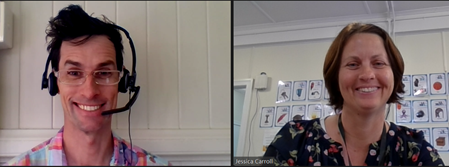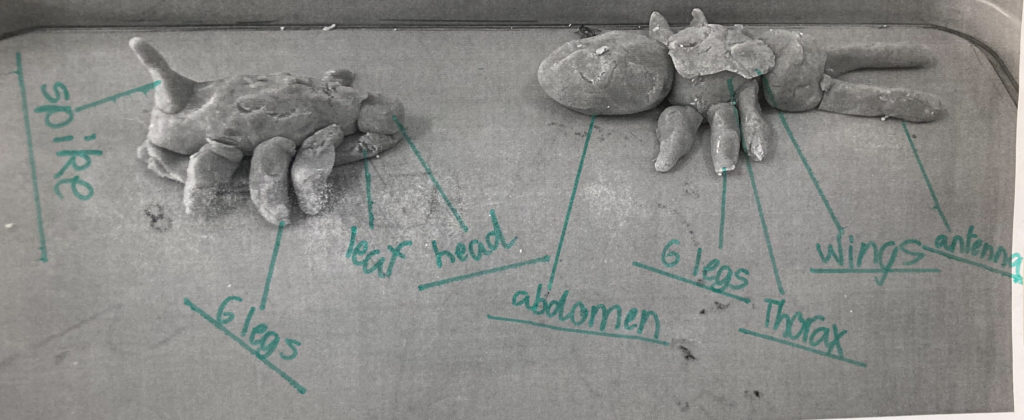This unique program of STEM professionals sharing their industry expertise in schools, no matter how small or remote, is opening up a world of possibilities.
That’s because reports show a large number of jobs are being computerised or automated, which means science, technology, engineering, and maths (STEM) skills are now more critical than ever.
One school that is both remote and small is St Patrick’s Catholic School, in Winton, Queensland. The school has just 20 students. Settle in to hear their story!
STEM professionals partner with teachers
At St Patrick’s Catholic School, a unique partnership is taking place between teacher Jessica Carroll and insect ecologist Dr Andy Howe.

Andy and Jessica meeting via Zoom.
Jessica and Andy have never met in person. Andy’s workplace, the University of the Sunshine Coast, is more than 1000 kilometres away.
However, the two are partners through the STEM Professionals in Schools program. It’s designed to bring real science, technology, engineering, and mathematics to life in classrooms around Australia by partnering STEM professionals with teachers.
Together, Jessica and Andy are enhancing science education for all year levels at the school. Their work has generated renewed enthusiasm for STEM subjects and a better understanding of potential career paths.
Distance: no barrier
Jessica is enthusiastic about the STEM professionals in schools partnership.
“Having extra support and knowledge from an expert is fabulous. Also, giving students the opportunity to meet and engage with a professional and learn about what they do is invaluable,” Jessica said.
“We have had whole school Zoom sessions with Andy. It’s been a wonderful opportunity for our students to ask him questions they have about insects, their projects, and science subjects in general.
”Topics they have looked at together include insect structure (morphology) and the different stages in their life cycles. We’ve discussed the different types of insects that can be found in the school yard and how they interact with their surrounding environment and different habitat conditions,” she said.
The students join together in age groups and have tackled several projects driven by data collection and interpretation, including observing ant responses to food availability, and hot and cold environments. Another group observed bean seeds in simulated flood and drought conditions. This helped them to quantify and discuss seed germination and plant growth.

Andy introducing his stick insect to the class to investigate insect morphology.
Virtual visits connect industry with the classroom
For Jessica and Andy to meet in person would require roughly a 14-hour drive – one way! So, it’s no surprise they opt to meet online via web conference.
Jessica recognises that although it would be amazing to welcome Andy on-site, the partnership has nevertheless been a great experience. She said it has provided the school with opportunities they could not have accessed otherwise.
“As we live remotely, it has been fabulous for the children to find out more about the different types of jobs that are out there, and to see jobs in science-related fields as normal,” said Jessica.
Andy has also found creative ways to engage the students virtually.
In one class, he displayed some videos of insects he had filmed in the field, demonstrating different insects’ behaviour.
One slow-motion video showed a mesmerising mate-finding dance by a swarm of small flies; another was of flies bouncing on spiderwebs. The students offered their thoughts on the different behaviours and discussed their theories with Andy.
Lessons imitating real-life science
Jessica is responsible for teaching the whole of school science – as one group. She also has to plan to meet the Australian curriculum requirements across all year groups.
It’s a daunting prospect, but one she and Andy tackle by using the inquiry method to set the students up as the researchers themselves, with age-appropriate learning area targets.
Andy says that using the scientific method in this way has made preparing activities that much easier as it’s similar to his usual work style.

Play-Doh insects created by students.
“As a researcher, it makes perfect sense to me. We apply the scientific method daily, discussing ideas and formulating hypotheses, designing tests of those hypotheses,” Andy said.
“Then, we interpret the data and move ahead with that information, informing new hypotheses. A lot of what I do with Jessica and the students uses processes that are similar to what I would employ during a typical day at work with my own colleagues.
“I like the idea of the kids thinking of themselves as researchers. They’re also using language related to research when describing the exercises or projects they undertake. It doesn’t matter at all if experiments don’t work out as planned. The scientific method allows for mishaps as a positive in the feedback loop which informs the next step. This is a great tool for kids to explore the world around them, regardless of the discipline.”
Time well spent
As much as the partnership has benefited the school, Andy also observes how the partnership has provided him with personal and professional benefits.
“Teachers face a huge task educating future generations. It is rewarding to lend a hand in a way that gives new purpose to my skills, while sharing my joy for insects,” said Andy.
“It is a meaningful way to volunteer my time and expertise. I find too that it is a very creative process. It requires me to think quickly and forces me to rethink how I communicate my science with a different audience.”


17th May 2021 at 10:41 am
In this world of hustle and bustle, it’s wonderful to have people who really care and who create historic references for everybody to see. One day, hopefully when it’s not too late, the leaders of the world today may put their egos on hold to seriously engage the people with our wonderful planet to preserve it, in good shape. Well done Sonia.
7th May 2021 at 10:13 am
This is such a brilliant idea. When I went to school I never got the chance to study about insects, plants and so much more. I have a great love of Botany because I paint our native plants. It has opened a whole world to me. My work has been published in a special booklet of disappearing plants of western Sydney. I am 75 and still learning. I love it. But I hated school brcause it was dead boring. I am an artist as well as a singer and songwriter. But painting these tiny plants was a labour of love to do. I am so nterested also in the relation between plants and insects and how they depend on each other. The cutting down of forests all over the world is of great concern and humans haven’t got the message that it leads to extinction and eventually might lead to our own extinction.